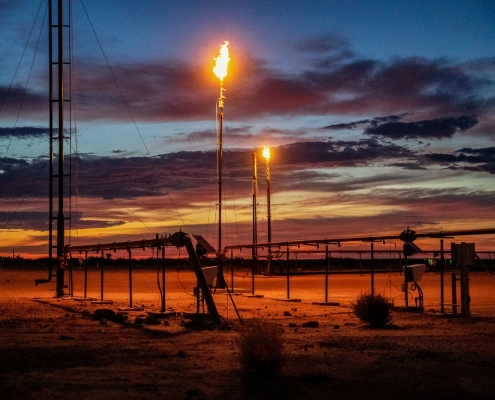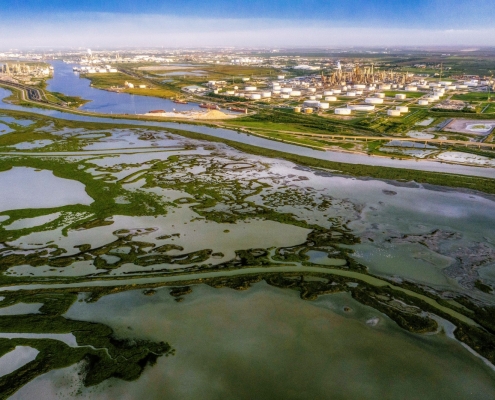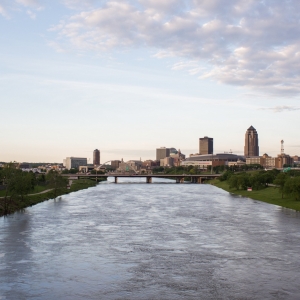Water Serves Length and Breadth of $1.9 Trillion Texas Economy
Growth in Wet Years, Economic Distress in Dry Ones
Growth in Wet Years, Economic Distress in Dry Ones
One big change in conserving water in Texas is the transition from thirsty fossil fuel electrical generation to renewable energy, which use scant amounts of water. Texas is a national leader in renewable energy. Video © Brian Lehmann / Circle of Blue
By Keith Schneider
Circle of Blue
WIMBERLEY, Texas – As a location for understanding the value of water, and a lesson in the consequences of scarcity, the five miles of Cypress Creek that flow through this active Hill Country town distill the essence of the role that water plays in the Texas economy.
Though it has miles of dry channel upstream, the creek’s permanent flow starts at Jacob’s Well, a famed Hays County artesian spring. From the dark blue hole that looks like an eye, Cypress Creek flows clear and steady downstream for about five miles before it meets the Blanco River. Along the way it encounters a popular swimming area known as Blue Hole, slips by a number of residences, and glides through Wimberley’s scenic center of shops, restaurants, and hotels. Land downstream of Jacob’s Well enjoyed a 25 percent to 40 percent premium in market value over land located along the upstream creek channels that were dry
In 2011, as the county’s population was doubling to well over 200,000 residents, and as the driest year in Texas unfolded, a research team from Texas State University’s Meadows Center for Water and the Environment arrived from San Marcos. Their focus was a novel study, completed in 2013, that is one of the most thorough assessments of the economic value of a small stream ever conducted in the United States.
Joining terrific data-gathering with complex financial formulas, the Meadows Center found that land downstream of Jacob’s Well enjoyed a 25 percent to 40 percent premium in market value over land located along the upstream creek channels that were dry. In some cases, researchers found, downstream properties were worth almost ten times — equal in many instances to more than $100,000 in the upscale Wimberley real estate market – more than upstream properties without water.
The Meadows Center study formally quantified what property buyers understand instinctively. The authors summed it up this way: “Home and land prices in the wet portion of the creek have price premiums associated with proximity to the creek. These enhanced values provide increased opportunities for property tax revenues, some of which could be used to help protect the creek and riparian areas.”
The research team also concluded that Cypress Creek was the most important natural asset and a principal reason that in 2010 Wimberley attracted 250,000 visitors. The creek’s allure was responsible for much, perhaps most, of the $60.5 million, 517-employee retail, recreational and tourism sector in this town of nearly 3,000 residents. “In 2010, the total direct impact of tourism in Wimberley’s economy highlights the role the creek plays,” wrote the study’s authors.
In fine detail, the Cypress Creek research illustrated the complex, multi-dimensional influence of fresh water in a small-town Texas economy. Though just a glimpse into a tiny region of a mammoth state, the study helped define the essential role that adequate supplies and harmful shortages exert on the economic well-being of all of Texas, a state whipsawed more than any other by devastating seasons of drought and flood, often occurring in the same year.

The annual $1.89 trillion Texas economy, the second largest state economy and ninth largest in the world, is entirely dependent on access to adequate supplies of water. Permian Basin oil and gas developments are among the state’s biggest industrial consumers of fresh water, and largest disposers of waste water. Photo © Brian Lehmann / Circle of Blue
It is common for water to be described as the lifeblood of human civilization. Without it, life is imperiled. On the other hand, too much can cause catastrophe. Rarely, even in Texas, is the contrast that absolute. In the daily commerce of Texas, its people, communities, and industries, water more closely aligns with music, a gift of human enterprise that makes its presence felt everywhere, accompanying every productive activity.
Like a great symphony, water generates remarkable benefits for a civilization’s body, mind, and spirit. The annual $1.89 trillion Texas economy, the second largest state economy and ninth largest in the world, is entirely dependent on access to adequate supplies of water. All 29.5 million Texas residents, and 13.7 million workers, rely on access to clean fresh water. Supplying drinking water and treating wastewater is such a big industry in Texas that it employs 10,300 people, according to federal figures from the Bureau of Labor Statistics.
But like a feverish movie soundtrack, water scarcity or overabundance portend calamity. The drought of the 1950s pushed 100,000 Texas farmers and ranchers out of business. The 2011 drought, which affected almost every county, caused $8 billion in agricultural losses, and indirect costs of $16.9 billion.
Some 500 million trees died in wildfires and drought that year, harming the state’s $18 billion timber industry alone. The Texas State Comptroller said drought resulted in a loss of 100,000 jobs. From 1980 to 2018, according to the National Oceanic and Atmospheric Administration, Texas led all states, by far, in losses from severe storms and flooding. In 2017 alone, Hurricane Harvey, a Category 4 storm that stalled near Houston, caused $125 billion in damages.
Since the 1950s, when Texas spent most of the decade contending with the consequences of the most severe period of drought in its contemporary history, the state has largely focused civic concerns and planning on avoiding cultural disruption and economic losses that accompany water scarcity. Yet rapid population growth and industrial development have outpaced the state’s capacity to relieve the pressure of deep droughts.
Three widely watched metrics support this conclusion: job losses, income reduction, and total dollar losses to the economy.
In the previous five-year State Water Plan published in 2012, the Texas Water Development Board, the central water data-gathering and planning agency, said that if the state didn’t act to conserve water and develop new supplies, a prolonged drought as dire as the one that occurred seven decades ago would be ruinous. By 2060, it projected, water scarcity would push 1 million people out of work, reduce incomes by $11.9 billion annually, and cause $115.7 billion in total annual losses to the economy.
In 2017, even with such practical changes as Panhandle farmers’ introduction of water-saving crop-production measures, and more of the state’s electricity being produced with wind and solar generation (which use scant amounts of water), the Texas Water Board said much more was required to secure the state’s water supply. In the State Water Plan published that year, the Water Board projected that unless more effective water management practices were adopted, by 2070 job losses would total 1.3 million, the drop in annual income would be $73 billion, and total losses to the economy would reach $151 billion.
“Water is the economy in Texas,” said Dr. Larry McKinney, executive director of the Harte Research Institute for Gulf of Mexico Studies in Corpus Christi. “It drives everything, particularly as you get less of it.”

Though the pandemic slowed construction around the Corpus Christi port, a new steel factory, liquid natural gas processing plant, a chemical plant, and storage tanks — require water. So much water the city is considering building two desalination plants to provide 94,000 acre-feet of water annually to industry. Photo © Brian Lehmann / Circle of Blue
Though the pandemic slowed construction around the Corpus Christi port, a new steel factory, liquid natural gas processing plant, a chemical plant, and storage tanks — require water. So much water the city is considering building two desalination plants to provide 94,000 acre-feet of water annually to industry. Photo © Brian Lehmann / Circle of Blue
Arguably the most crucial factor in reducing consumption and preparing for scarcity in Texas –and every other place, for that matter — is the economically illogical fact of market prices for water. Economists insist that competitive markets are the most efficient tool for managing supply and demand of a scarce resource. Yet even though it’s an elemental and immensely valuable natural resource essential to the functioning of a stable society, when it comes to scarcity, water defies classic market theory.
The paradox of the low value of scarce Texas water is most profound in the state’s $25 billion farm and ranch sector. Farmers and ranchers will consume about 60 percent of the 18.4 million acre-feet of water needed in Texas this year. And except for pumping, transport and irrigation costs, farmers and ranchers who own their water rights pay nothing for their water. Farmers that rely on an irrigation district, like rice growers served by the Lower Colorado River Authority, pay about 11 cents for 1,000 gallons.
A study by the Dallas Federal Reserve Bank found that such low prices contributed to a striking imbalance in the Texas economy between the sectors that use the most water and those that contribute the most to the economy. Though roughly six out of ten gallons of available supply are consumed by growers, said the bank, “the direct contribution of agriculture production to the economy” is less than 1 percent.
In cities served by municipal water utilities, the price of water is much higher, reflecting the cost of service. Water utilities in Austin, El Paso and San Antonio set a tiered price structure for their customers: those who use the most have the highest rates. But utility managers in the three cities — regarded as some of the most ardent water-conserving metro centers in the world — all said they are reluctant to use increases in the price of water as a tool to reduce demand.
The competitiveness of their cities depends, in part, on keeping water utility rates down. In national surveys of municipal water pricing, the three Texas cities are in the middle of the pack.
Still, customers can expect higher water prices as cities prepare for scarcity. San Antonio in May opened a $1 billion pipeline to transport 50,000-acre feet of water drawn annually from the Carrizo-Wilcox aquifer east of the city. The pipeline adds $12 to the average $75 monthly residential water bill.
El Paso has spent almost $220 million to purchase 66,000 acres and obtain thousands of acre-feet of water rights on land near Dell City in anticipation of needing to build, sometime in the future, a billion-plus dollar pipeline to the region about 100 miles away.
The place where supply and demand for water draws a bit closer to conventional market norms is in the Permian Basin, where ranchers with water rights are selling their water to oil and gas developers for drilling and fracking. In Pecos County, a group of ranching and farming families near the county’s western boundary with Reeves County have agreements to sell 12,000 acre-feet of water annually to oil and gas developers. The price, said Ty Edwards, general manager of the Middle Pecos Groundwater Conservation District, is 35 cents a barrel, or a little less than a penny a gallon.
There are 7,758 barrels in an acre-foot, worth $2,716. Sales of 12,000 acre-feet at full production earn the families a total of $32.6 million. “I’ll tell you,” said Edwards, “they don’t have to farm that land now.”
The civic resource underlying San Antonio’s $15.2 billion annual tourism sector is the River Walk. Photo © J. Carl Ganter / Circle of Blue
Almost seven years ago Texas voters approved establishing a $2 billion revolving loan fund to help finance and leverage billions more dollars in water supply and conservation projects to reduce the state’s vulnerability to droughts. The Texas Water Development Board oversees the fund. A report by the Texas Comptroller said that in four early years of the loan program, from 2015 through 2018, the loan fund helped finance 54 projects valued at more than $8 billion.
The latest State Water Plan anticipates Texas will need $63 billion more to fund over 5,000 water supply and conservation projects. Almost 60 percent will require state assistance.
How much larger that tally will be in the next State Water Plan, due in 2022, is far from clear. Up for debate is the mix of projects that local governments, water utilities, river authorities, irrigation districts, and groundwater conservation districts propose. Are new billion-dollar reservoirs and pipelines a logical response to scarcity? Is fixing leaks in irrigation canals and city pipes at lower cost a smarter investment? Can water-conserving buildings, like those built in Austin, be duplicated in other cities?
What’s not up for debate is the essential need for adequate water supplies and its influence on the state’s economy and way of life. In 2010, the group studying the value of Cypress Creek found that if Jacob’s Well stopped flowing and the creek went dry for a long period, the market value of the properties close to the shoreline would drop 25 percent to 40 percent. That one metric reveals how people and markets react to scarcity.
Across Texas, ties between water and the economy are revealed in innumerable places, in sturdy connections that bind the state together. One such union between a Texas place and the value of water is so penetrating and relevant it’s known around the world. That place is San Antonio and its River Walk.
Initially designed as a flood protection bypass for the San Antonio River, the River Walk has become a 15-mile pedestrian pathway through the entire city. Where it flows through center city, River Walk is, in typical years, a stirring showcase of restaurants, night spots, and hotels alive with thousands of visitors, particularly in the alluring shadows of evening lamps and signs.
Other cities in the United States and around the world have tried to duplicate the restoration principles that produced the River Walk. Oakland, California approved a $198 million bond to remove concrete culverts that served for decades as straitjackets on streams flowing from its coastal hills, and to restore the natural flow to Lake Merritt, the city’s centerpiece park.
Seoul, South Korea spent $384 million to demolish a central city highway and construct wastewater treatment plants that turned the Cheonggyecheon River into a promenade of reedy banks and tranquil pools of clean water. Malaysia spent $1.3 billion to restore and redevelop 6.2 miles of the Klang River in central Kuala Lumpur, its capital city, one of the hardest and most expensive urban river revival projects ever undertaken.
None of these river redevelopment projects, and few others around the world, match the cultural and economic success of the River Walk. The economic metrics supporting that conclusion are impressive. Assessments by the San Antonio Convention and Visitors Bureau and other local development groups find that 37 million people visit the city each year, generating 21,000 jobs, and $15.2 billion, or 12 percent, of San Antonio’s annual $120 billion-plus economy. Almost every study finds the civic resource underlying San Antonio’s tourism sector is the River Walk.
Water and economy. Music and life-in-balance. San Antonio’s River Walk, like the promenade along the Seine in Paris, is one of the world’s premier examples of the value of fresh water to a splendid city’s economy and way of life.
Water, Texas is a six-part series on the consequences of the mismatch between runaway development and tightening constraints on the supply and quality of fresh water in Texas.
Funded by the Cynthia & George Mitchell Foundation.
Photography:
Brian Lehmann
Data Visualizations:
Claire Kurnick
Joe Warbington – Vizlib
Pablo del Cerro – T Maker
Stay informed about global WaterNews and never miss any of Circle of Blue’s award-winning reporting by joining our weekly newsletter.
Have new, international water news delivered to you daily by signing up for Circle of Blue’s The Stream.
Signup for the Federal Water Tap, Brett Walton’s weekly digest of U.S. government water news.
Circle of Blue’s senior editor and chief correspondent based in Traverse City, Michigan. He has reported on the contest for energy, food, and water in the era of climate change from six continents. Contact
Keith Schneider

 What’s Up With Water – August 31, 2020
What’s Up With Water – August 31, 2020